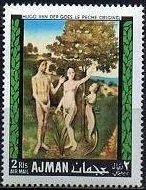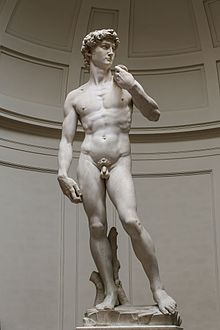Stamp: The Fall by Hugo van der Goes (about 1440-1482) (Ajman 1968)
The Fall by Hugo van der Goes (about 1440-1482) (Ajman 1968)
05 July (Ajman ) within release Paintings: Adam and Eve goes into circulation Stamp The Fall by Hugo van der Goes (about 1440-1482) face value 2 United Arab Emirates riyal
| Stamp The Fall by Hugo van der Goes (about 1440-1482) in catalogues | |
|---|---|
| Michel: | Mi:AJ 284A |
Stamp is square format.
Also in the issue Paintings: Adam and Eve:
- Stamp - Adam by Albrecht Dürer (1471-1528), german painter face value 2;
- Stamp - The Fall (12th century) face value 2;
- Stamp - Adam and Eve by Lucas Cranach t.E. (1472-1553) german painte face value 2;
- Stamp - The Fall by Hugo van der Goes (about 1440-1482) face value 2;
- Stamp - Adam and Eve, by Lucas Cranach t.E. (1472-1553) face value 2;
- Stamp - Adam by Albrecht Dürer (1471-1528) face value 2;
- Souvenir Sheet - Adam, by Albrecht Dürer face value 5;
- Stamp - The Fall by Hugo van der Goes (about 1440-1482) face value 2;
- Stamp - The Fall by Maderuelo (12th century) face value 2;
- Full Pane - Adam and Eve, Lucas Cranach face value 20*2;
- Full Pane - Adam and Eve, Lucas Cranach face value 20*2;
- Full Pane - Adam, Albrecht Dürer face value 20*2;
- Full Pane - Adam, Albrecht Dürer face value 20*2;
- Full Pane - The Fall, Hugo van der Goes face value 20*2;
- Full Pane - The Fall, Hugo van der Goes face value 20*2;
- Full Pane - The Fall, Maderuelo face value 20*2;
- Full Pane - The Fall, Maderuelo face value 20*2;
Stamp The Fall by Hugo van der Goes (about 1440-1482) it reflects the thematic directions:
Painting is the practice of applying paint, pigment, color or other medium to a solid surface (support base). The medium is commonly applied to the base with a brush, but other implements, such as knives, sponges, and airbrushes, can be used. Painting is a mode of creative expression, and the forms are numerous. Drawing, gesture (as in gestural painting), composition, narration (as in narrative art), or abstraction (as in abstract art), among other aesthetic modes, may serve to manifest the expressive and conceptual intention of the practitioner. Paintings can be naturalistic and representational (as in a still life or landscape painting), photographic, abstract, narrative, symbolistic (as in Symbolist art), emotive (as in Expressionism), or political in nature (as in Artivism). A portion of the history of painting in both Eastern and Western art is dominated by spiritual motifs and ideas. Examples of this kind of painting range from artwork depicting mythological figures on pottery, to Biblical scenes rendered on the interior walls and ceiling of the Sistine Chapel, to scenes from the life of Buddha or other images of Eastern religious origin. In art, the term painting describes both the act and the result of the action. The support for paintings includes such surfaces as walls, paper, canvas, wood, glass, lacquer, clay, leaf, copper and concrete, and the painting may incorporate multiple other materials including sand, clay, paper, plaster, gold leaf, as well as objects. The term painting is also used outside of art as a common trade among craftsmen and builders.
Painting is a visual art, which is characterized by the practice of applying paint, pigment, color or other medium to a solid surface The medium is commonly applied to the base with a brush, but other implements, such as knives, sponges, and airbrushes, may be used. One who produces paintings is called a painter.
The nude, as a form of visual art that focuses on the unclothed human figure, is an enduring tradition in Western art. It was a preoccupation of Ancient Greek art, and after a semi-dormant period in the Middle Ages returned to a central position with the Renaissance. Unclothed figures often also play a part in other types of art, such as history painting, including allegorical and religious art, portraiture, or the decorative arts. From prehistory to the earliest civilizations, nude female figures were generally understood to be symbols of fertility or well-being.



